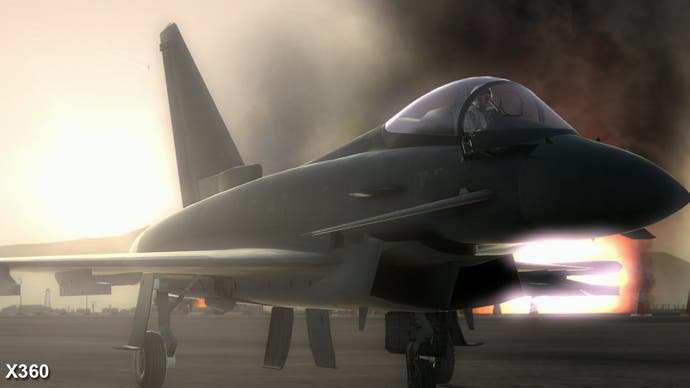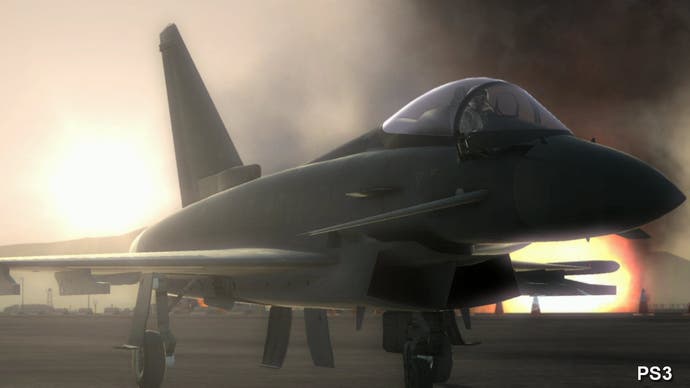Face-Off: Tom Clancy's H.A.W.X. 2
Which is Top Gun?
| - | Xbox 360 | PlayStation 3 |
|---|---|---|
| Disc Size | 6.0GB | 8.66GB |
| Install | 6.0GB (optional) | 5913MB (mandatory) |
| Surround Support | Dolby Digital | Dolby Digital, 5.1LPCM, 7.1LPCM |
Back in 2006, the Romanian wing of Ubisoft developed the somewhat hit-and-miss air combat shooter, Blazing Angels. Sometimes graphically inept, occasionally beautiful, the developer somehow managed to capture the thrill and the excitement of close-quarters dog-fighting via an interesting use of dynamic cameras you could activate with a button press.
While sales were lacklustre, clearly the powers-that-be at Ubisoft thought that there was something worthwhile here, taking the team's expertise in air combat and channelling it into a new project for the megabucks Tom Clancy franchise. The result was H.A.W.X. - an enjoyable, visually impressive, if rather limited and somewhat repetitive shooter.
Just 18 months later the sequel has arrived, with an obvious graphical facelift combined with far more thought invested into the single-player campaign mode. Tom Clancy's H.A.W.X. 2 is a really decent game, but can the PlayStation 3 release match the undoubted quality of the reviewed 360 version? It's time to find out, with the usual comprehensive range of shots in the comparison gallery, along with the requisite video. Remember to hit the full-screen button for the benefit of full 720p resolution.
Let's get straight down to the nitty-gritty. In terms of the make-up of the framebuffer, both games operate at native 720p, the main difference coming down to the utilisation of anti-aliasing. In the original H.A.W.X., the 360 version operated with 4x multi-sampling anti-aliasing, while PS3 used a blur effect to smooth off the jaggies.
For the sequel, the situation is unchanged on the Microsoft console but things have improved on the PS3: 2x AA has been added, accompanied by a full-screen blur. The result is that the 360 game looks a touch clearer and sharper, but the overall difference is actually fairly minimal.


The most obvious departure between the new H.A.W.X. and its predecessor concerns frame-rate. Perhaps influenced by Ace Combat from Namco, Ubisoft Romania targeted 60FPS for the first game, resulting in a very smooth, responsive game - for the most part. Problems occurred when the engine was under load, resulting in some pretty steep drops in performance. Setting a budget of 16ms to render each frame also resulted in a lack of processing time for rendering effective ground scenery.
One of the biggest complaints about the original game was the low-res texturing witnessed when flying close to the deck, and the lack of 3D ground detail: a city would consist of a flat texture with rectangular boxes protruding from the ground to represent skyscrapers. So, hardly impressive stuff then.
Ubisoft's solution for the sequel was to forego 60FPS completely and drop down to a v-synced, double-buffered 30FPS. In ideal conditions, what this means is that the current image remains on screen for 33ms, while the renderer time generates the next frame. The framebuffer itself is then flipped and the process repeats. Double the amount of rendering time compared to the first game has allowed Ubisoft to add much more in the way of actual 3D detail to the scene, so low-altitude flying is much more of a fulfilling experience this time around: buildings, trees, foliage, it's all there. Overlaid on top of the existing texture work that Ubisoft has licensed from GeoEye, the overall effect is that the scenes are far more convincing overall - the graphical upgrade is self-evident.
The drop to 30FPS has other advantages too. Take for example the oil rig stage. This is set out on the oceans, so effectively all the rendering budget can be used for intricate sea-level buildings - a complex series of rigs and refineries, armed to the teeth with flak cannons, enemy helicopters and fighter planes weaving in and out of the environments. It's unlikely that stages like this would've been possible running with the original H.A.W.X. tech, and it's the general increase in variety and the more impressive scope of the game's concepts that are the main successes of the sequel.
Generally speaking, the double-buffered v-synced 30FPS seen in H.A.W.X. is fine - with just one caveat: frame-rate really needs to be sustained at that 30FPS level otherwise bad things can happen. If a frame goes over-budget and isn't ready in time for the refresh, you need to wait for the next, resulting in an effective momentary drop to 20FPS. With that in mind, performance becomes one of the most important elements for H.A.W.X. 2, so let's get to it straight away with a series of five clips for analysis, taken from the same points in the game on both Xbox 360 and PlayStation 3.
Generally speaking, that 30FPS is sustained very well on Xbox 360, with just the odd explosion causing a splutter down to 20FPS. The performance of PlayStation 3 often manages to keep pace but can lose frames depending on the make-up of the level. Some stages operate at a consistent 30FPS and there is no difference at all between the two games in terms of how they play: mission successful.
Other levels seem to cause real issues for the PlayStation 3, the afore-mentioned oil rig stage in particular often seeing consistent, lengthy drops at the 20FPS level. Maintaining an arena crammed with opponents can also causes issues for the PS3, which is a bit of a shame bearing in mind that the strengths of the online game in particular come from the sense that you're just a minor player in a fairly vast theatre of combat, with many enemy units to face-off against.
The Xbox 360's weakness with screen-filling explosions is amplified somewhat on PlayStation 3, often resulting in some correspondingly low response from the controller. Less importantly, cut-scenes also appear prone to frame-rates drops too. The development team hasn't made use of the usual trick of dropping down to a lower resolution alpha buffer (as utilised in many Sony first party titles) meaning that both bandwidth and fill-rate limitations cause really issues here - the bigger the explosion, the higher the load on the GPU, and the more frame-rate drops.
The overall conclusion is fairly straightforward - 360 is far more successful in consistently achieving the target frame-rate, while in certain situations, the PS3 can falter, sometimes dramatically so.


